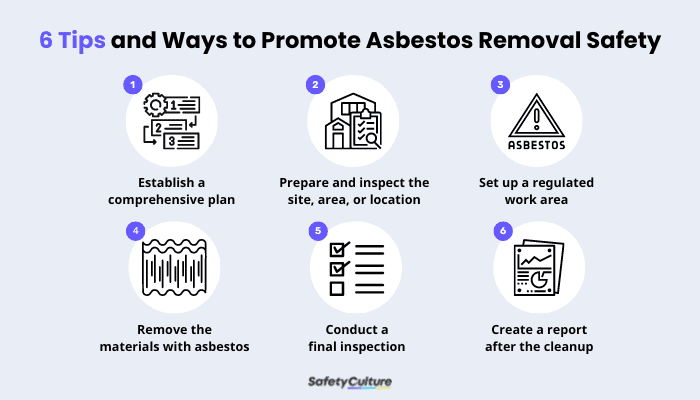What is Asbestos Removal?
Asbestos removal is the process of safely removing Asbestos-Containing Materials (ACMs), from a building or a structure, that have been disturbed or destroyed. Disturbed or destroyed ACMs can release asbestos fibers that when inhaled or ingested, can threaten human health. Hence, this process is highly regulated, and must only be performed by licensed professionals.
Importance
Asbestos is a material made of silicate mineral found in nature that’s found and used in a wide range of manufactured products due to its durability, resistance to fire, and flexibility. These include building materials such as roofing shingles and tiles, friction products such as brake and transmission parts, and packaging. Asbestos is composed of thin, flexible fibers when viewed under a microscope. These fibers, when inhaled or ingested, can cause mesothelioma and other asbestos-related diseases such as lung cancer and asbestosis.
Mishandling of asbestos doesn’t just threaten the health and safety of those who are dealing with it, but also those around them with no proper Personal Protective Equipment (PPE) or other ways to protect themselves in lessening their exposure. Hence, establishing safety measures is non-negotiable, and seeking professional help to perform this task is the most advisable way to go.
In most cases, ACMs that are well-maintained or undisturbed don’t necessarily have to be removed. When needed, though, asbestos removal is beneficial to help eliminate its risks to humans
Tips and Ways How to Promote Asbestos Removal Safety

Tips and Ways to Promote Asbestos Removal Safety
With the various health risks and hazards that asbestos poses to humans, its proper handling and disposal are highly encouraged. Apart from the rule of thumb that only licensed professionals must perform these procedures, here are some tips and ways to help ensure a safe asbestos removal process:
Establish a comprehensive plan
Prior to the removal process itself, the people in charge (i.e., industrial hygienist, safety supervisor, or contractor) must collaborate to provide details on how the area must be treated. These details must be laid out in a comprehensive plan, from the commencement of tasks to the cleanup process after the asbestos removal.
For this task, it’s helpful to create an asbestos inspection checklist to identify the location of existing or potential ACMs to help lessen or eliminate human exposure which can then lead to health and safety hazards. This checklist can also be used by certified inspectors in assessing the overall condition of a facility and how employee safety measures are being implemented in compliance with regulatory requirements.
On the other hand, the safety of workers who’ll perform the removal process must also be prioritized given the risks they may face. Hence, the industrial hygienist or safety supervisor must also use a PPE safety checklist to ensure their stocks of PPEs are sufficient and of good quality.
Create Your Own Asbestos Safety Inspection Checklist
Prepare and inspect the site, area, or location
Following the plan, contractors must then properly mark the hazardous areas where ACMs are through demarcation. It’s also a must to inform the people around the vicinity (e.g., tenants in a commercial building) to leave the area until the removal process is complete and cleared.
Set up a regulated work area
Make sure all Heating, Ventilation, and Airconditioning (HVAC) units are turned off and air ducts are sealed. Also, areas that won’t be treated must be securely sealed off with plastic sheeting. All of these must then be checked by the industrial hygienist or safety supervisor before endorsing the work area to the contractor for the commencement of the removal process.
Remove the materials with asbestos
For the actual removal of ACMs, contractors use hand tools and wet methods while wearing PPEs such as coveralls and respirators. Once removed, the ACMs must be properly sealed and disposed using waste disposal bags. During and after the removal process, special kinds of vacuums with High-Efficiency Particulate Air (HEPA) filtration functionality for asbestos removal purposes must be used to minimize the dispersion of asbestos fibers.
Adjacent to the work area, a decontamination chamber must also be established, with a designated shower that contractors and workers can use when exiting the work area.
Conduct a final inspection
The industrial hygienist or safety supervisor must double-check the work done by performing clearance air sampling in compliance with state laws and regulations. During the final inspection, the work area barriers and air filtration must be kept intact until clearance testing is done.
Create a report after the cleanup
To properly document the completion of the removal process, the contractor should finalize a report containing asbestos waste shipment details, site logs, licensing, and specific tasks done. The industrial hygienist or safety supervisor should also come up with a report that details the inspection results, analysis, and other recommendations for future asbestos removal processes. These reports support an organization’s recordkeeping and good documentation practices for maintaining compliance with environmental regulations.
Rules and Regulations for Handling Asbestos
While each state, region, and country has its own agencies and regulatory bodies governing asbestos handling and removal, the following list includes some the most basic and widely referenced laws and regulations:
- United States
- Occupational Health and Safety Administration (OSHA)
- Environmental Protection Agency (EPA)
- Clean Air Act of 1970 – where the EPA established the Asbestos National Emission Standard for Hazardous Air Pollutants (NESHAP)
- Asbestos Hazard Emergency Response Act (AHERA) – an EPA regulation addressing asbestos found in schools and learning facilities
- Australia
- United Kingdom
- International Labour Organization



